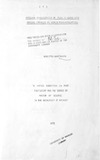| dc.description.abstract | A survey was undertaken between November 1976 and 1977
to assess the hygienic quality of the fish sold in Kenya.
This was accomplished by evaluating the total bacterial
count and coliform count per gram of the sample. In addition,
the prevalence rate of y. parah3emolyticus a halophilic
bacterium causing gastroenteritis in humans, V. Cholerae
biotypes and Sa lmone 11ae species was determi ned, The
haemolytic properties, growth characteristics, egg pathogenicity
and antimicrobial 9rug sensitivities of the V.
parahaemolyticus isolates were studied. Electron microscopy
techniques were employed to elucidate the morphology of
isolate X1Gl later confirmed to be serotype 0-10, K-23 of
V. parahaemolyticus.
A total of 993 ~amples collected from the Coast Province
and Nairobi area comprised of seafish, shellfish (crustacean
and mollruscan), sediment and lake fish. Seafish, water and
sediment constituted 81.4% (912) of the total number of
samples. Lake fish (81) accounted for 8.2%.
The total bacterial and coliform counts per gram of
the sample were determined using Total Plate Count agar
and Vidlet Red Bile Salt Dextrose agar medium respectively
Thermophilic coliforms were sought by incubating Violet~ed Bile
Salt Dextrose agar plates at 440C instead of 370C for
24 hours. Enrichment procedures for the isolation of y.
parahaemolyticus, ~. Cholerae and Salmonellae species were
carried out in Glucose Salt Teepol Broth, Peptone water and
tetrathionate or Selenite broths respectively. Subsequent
plating for selective isolation was done on Thiosulphate
Bile-Salt-Sucrose (TCBS) for ~. parahaemolyticus and
~. Cholerae, while Bromothymol Glue agar media were used for
Salmonellae. Characteristic colonies thus obtained were
subjected to appropriate biochemical tests after their
morphologies in the light and electro-n microscopes., were studied.
Total bacterial counts ranged between 2 x 106 to 2 x 1012
per gram, of fresh sea fish samples. Salted smoke-dried lake
fish exhibited bacterial counts ranging from 7 x 103 to 6 x 107
per gram. The coliform counts for both categories of fish
appeared to bear a positive relationship to the corresponding
total bacterial counts in each sample. The higher or lower
the bacterial count, the higher or· lower the coliform count.
Neither Salmonellae species no~~. Cholerae were isolated
from the samples processed. An overall prevalence r:1:e for
~. parahaemolyticus of approximately 8. 1% was computed for
all the samples tested. Variation in the prevalence rates
due to this bacterium existed among the sample types from
Nairobi Area and the Coast Province. The prevalence rates
differed for the sample types. The ubiquitous ~. alginolyticus
and Proteus vulgaris were isolated from all the marine samples.
However there was a preponderance of Proteus vulgaris in all
lake fish samples. Other flora recovered included Pseudomonas
species from both marine and lake samples and Alcali~nes
faecalis only from marine samples.
The optimal Sodium chloride (NaCl) concentration
conduci ve for the propaga tion of serotype 0-10, K-23 of
'i. parahaemolyticus was found to be between 1.5% and 3.5%. The
growth of this serotype above 9.5% and below 1.5% NaCl was
minimal before 24 hours, compared to that at optimal Sodium
chloride concentrations. Ability to thrive and propagate
belowl.5%Sodium chloride concentration in the medium was
thought to be a strain adaptation. None of the~. parahaemolyticus
isolated could survive at pH 4.5. The optimal pH
for propagation was 8.2. No visible colonies were formed by
the isolates when the TCBi agar plates were kept at OOC and +40C
although the.' viability of these cultures was certain after
storage at these low temperatures.
No clear zone of B-haemolysis was observed around the
colonies of the 72 V. parahaemolyticus isolates or.\·Jagatsuma
Blood Agar (WBA) medium, hence they were termed, Kanagawa
negative (K-ve). Similar mortality rates exhibited by the
10 day old chicken embryos after inoculation with serotype
0-10, K-23 and the reference K-ve culture was indicative of
their relative multiplication rate and perhaps similar
virulence.
It is therefore recommended that the Public Health
Officials should exercise control over all handling and
processing of fish and shellfish for marketing as well as
educating the consumers in the hygienic handling and
preparing of fish and other seafoods for consumption | en |

